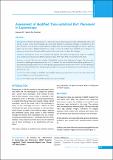Please use this identifier to cite or link to this item:
https://hdl.handle.net/20.500.14356/1034Full metadata record
| DC Field | Value | Language |
|---|---|---|
| dc.contributor.author | KC, Kamana | - |
| dc.contributor.author | Shrestha, Manish | - |
| dc.date.accessioned | 2023-04-20T07:23:14Z | - |
| dc.date.available | 2023-04-20T07:23:14Z | - |
| dc.date.issued | 2022 | - |
| dc.identifier.citation | KCK., & ShresthaM. (2022). Assessment of Modified Trans-umbilical Port Placement in Laparoscopy. Journal of Nepal Health Research Council, 20(01), 173-179. https://doi.org/10.33314/jnhrc.v20i01.3937 | en_US |
| dc.identifier.issn | Print ISSN: 1727-5482; Online ISSN: 1999-6217 | - |
| dc.identifier.uri | http://103.69.126.140:8080/handle/20.500.14356/1034 | - |
| dc.description | Original Article | en_US |
| dc.description.abstract | Abstract Background: Primary port placement is a critical step in any laparoscopic procedure. Although the safety and efficacy of open versus closed technique has been much debated, no particular technique is considered as the best. Therefore, over the period of time different methods have been developed and applied in order to perform laparoscopy procedures, Midat hospital has been using a version of modified trans-umbilical open technique for primary port entry from 2 decades and this study is being carried out to evaluate the technique. Methods: Retrospective review was conducted. The patients who underwent laparoscopy surgery by modified trans-umbilical port placement at Midat hospital from June 2019- April 2020 were included in this study. Results: A total of 100 cases were studied. Cholelithiasis was the main indication of surgery. The mean time recorded to establish pneumoperitoneum was 3.4±1.3 minutes. The rate of umbilical swab culture growth was 1%, pre-peritoneal port placements was 2%. Post-operative primary port site infection rate was 4%. No intra-abdominal injury was noted during the entry of primary port and there was no port site hematoma or recorded hernia over the period of one year. Conclusion: This technique of modified trans-umbilical primary port placement is one of the safest, fastest and easiest techniques to enter the peritoneal cavity. Keywords: Laparoscopy, trans-umbilical primary port, open technique. | en_US |
| dc.language.iso | en | en_US |
| dc.publisher | Nepal Health Research Council | en_US |
| dc.relation.ispartofseries | Jan-March, 2022;3937 | - |
| dc.subject | Laparoscopy | en_US |
| dc.subject | trans-umbilical primary port | en_US |
| dc.subject | open technique | en_US |
| dc.title | Assessment of Modified Trans-umbilical Port Placement in Laparoscopy | en_US |
| dc.type | Journal Article | en_US |
| local.journal.category | Original Article | - |
| Appears in Collections: | Vol. 20 No. 01 (2022): Issue 54 Jan-March, 2022 | |
Files in This Item:
| File | Description | Size | Format | |
|---|---|---|---|---|
| 3937-Manuscript-27972-1-10-20220609.pdf | Fulltext Download | 726.69 kB | Adobe PDF |  View/Open |
Items in DSpace are protected by copyright, with all rights reserved, unless otherwise indicated.
